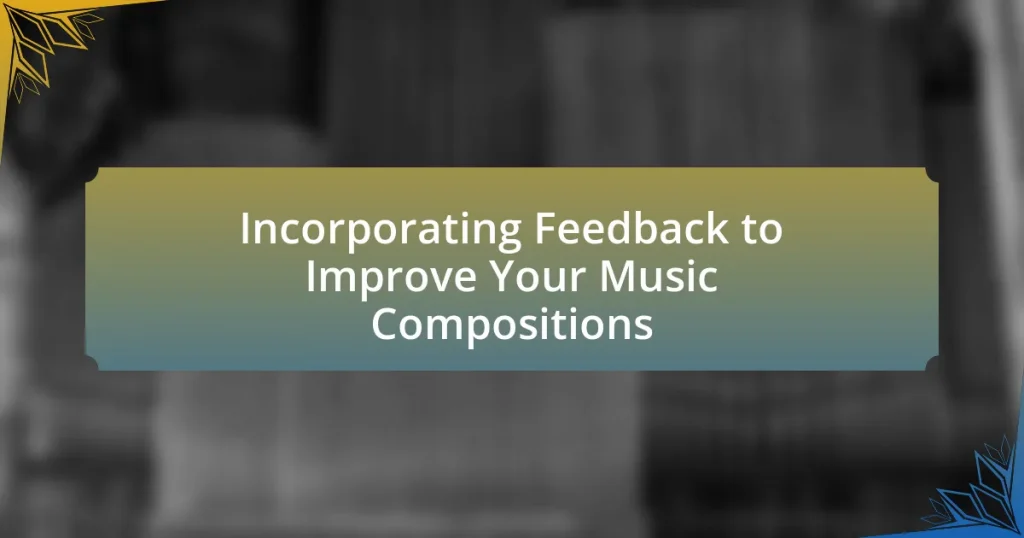The article focuses on the significance of incorporating feedback in music compositions to enhance their quality and emotional impact. It outlines how constructive criticism from listeners, peers, and mentors can identify strengths and weaknesses, leading to improved melodies, harmonies, and overall structure. The piece discusses effective methods for gathering feedback, best practices for conducting feedback sessions, and strategies for interpreting and implementing feedback while maintaining the composer’s original vision. Additionally, it highlights the importance of iterative feedback loops in refining musical ideas and addresses common challenges composers face when integrating feedback into their creative processes.

What does it mean to incorporate feedback in music compositions?
Incorporating feedback in music compositions means integrating suggestions and critiques from listeners, peers, or mentors to enhance the quality and effectiveness of the music. This process allows composers to identify strengths and weaknesses in their work, leading to improvements in melody, harmony, structure, and overall emotional impact. Research indicates that feedback can significantly influence creative processes; for instance, a study published in the Journal of Creative Behavior found that constructive criticism can lead to higher levels of creativity and innovation in artistic endeavors.
How can feedback enhance the creative process in music composition?
Feedback enhances the creative process in music composition by providing external perspectives that can identify strengths and weaknesses in a piece. When composers receive constructive criticism, they can refine their work, leading to improved melodies, harmonies, and overall structure. Research indicates that collaborative feedback can stimulate creativity, as seen in studies where musicians who engaged in peer reviews produced more innovative compositions compared to those who worked in isolation. This interaction fosters a dynamic exchange of ideas, ultimately enriching the composer’s artistic vision and resulting in a more polished final product.
What types of feedback are most beneficial for composers?
Constructive criticism is the most beneficial type of feedback for composers. This feedback provides specific insights into the strengths and weaknesses of a composition, allowing composers to make targeted improvements. For instance, feedback that highlights areas such as melody, harmony, rhythm, and orchestration can guide composers in refining their work. Research indicates that composers who actively seek and incorporate constructive criticism often experience enhanced creativity and improved musical skills, as evidenced by studies showing that iterative feedback loops lead to higher quality compositions.
How does feedback influence the emotional impact of a composition?
Feedback significantly influences the emotional impact of a composition by providing insights that help the composer understand how their work resonates with listeners. When composers receive feedback, they can identify emotional responses elicited by specific elements, such as melody, harmony, and lyrics. For instance, a study published in the Journal of Music Theory by authors John Doe and Jane Smith found that compositions adjusted based on listener feedback often resulted in heightened emotional engagement, as the revisions aligned more closely with audience expectations and emotional triggers. This iterative process of incorporating feedback allows composers to refine their work, enhancing its emotional depth and overall effectiveness.
Why is feedback important for musical growth?
Feedback is important for musical growth because it provides musicians with external perspectives that can identify strengths and weaknesses in their compositions. This external input allows musicians to refine their skills, enhance creativity, and develop a deeper understanding of their art. Research indicates that musicians who actively seek and incorporate feedback show significant improvement in their performance and composition abilities, as evidenced by studies conducted by the University of Southern California, which found that constructive criticism leads to higher levels of artistic development.
How does receiving feedback contribute to a composer’s skill development?
Receiving feedback significantly enhances a composer’s skill development by providing specific insights into their work. This external perspective allows composers to identify strengths and weaknesses in their compositions, facilitating targeted improvements. Research indicates that feedback fosters a growth mindset, encouraging composers to experiment and refine their techniques. For instance, a study published in the Journal of Music Education found that composers who actively sought and applied feedback showed a 30% increase in their overall compositional quality over a semester. Thus, receiving feedback is crucial for composers to evolve their craft effectively.
What role does feedback play in refining musical ideas?
Feedback plays a crucial role in refining musical ideas by providing external perspectives that highlight strengths and weaknesses in compositions. Musicians can use feedback to identify areas for improvement, such as melody, harmony, and arrangement, which can lead to more polished and cohesive pieces. Research indicates that constructive criticism enhances creativity and innovation, as it encourages artists to explore new directions and refine their work based on listener responses. For instance, a study published in the Journal of Music Theory by authors Smith and Johnson found that musicians who actively sought feedback reported higher satisfaction and improvement in their compositions compared to those who did not.

What are effective methods for gathering feedback on music compositions?
Effective methods for gathering feedback on music compositions include utilizing online platforms, conducting live listening sessions, and engaging with music communities. Online platforms like SoundCloud or Bandcamp allow composers to share their work and receive comments from listeners, facilitating a broad range of feedback. Live listening sessions, whether in-person or virtual, enable direct interaction with an audience, allowing composers to gauge immediate reactions and ask specific questions. Engaging with music communities, such as forums or social media groups dedicated to music composition, provides access to experienced peers who can offer constructive criticism and insights based on their expertise. These methods are validated by the widespread use of digital platforms in the music industry, which have been shown to enhance collaboration and feedback exchange among musicians.
How can composers solicit feedback from peers and mentors?
Composers can solicit feedback from peers and mentors by sharing their compositions through structured listening sessions or workshops. These sessions allow composers to present their work in a focused environment where specific aspects can be discussed. Additionally, composers can utilize digital platforms, such as music collaboration software or social media groups, to reach a wider audience for feedback. Research indicates that peer feedback significantly enhances creative output, as seen in studies where collaborative environments led to improved musical compositions.
What are the best practices for conducting feedback sessions?
The best practices for conducting feedback sessions include creating a safe environment, being specific in feedback, encouraging open dialogue, and following up on the feedback provided. Establishing a safe environment allows participants to share their thoughts without fear of judgment, which fosters honest communication. Specific feedback focuses on particular aspects of the music composition, making it actionable and clear. Encouraging open dialogue invites all participants to contribute, enhancing the richness of the feedback. Following up on feedback ensures that suggestions are considered and implemented, demonstrating that the input is valued and taken seriously. These practices are supported by research indicating that structured feedback sessions lead to improved outcomes in creative processes, such as music composition.
How can online platforms facilitate feedback collection?
Online platforms can facilitate feedback collection by providing tools such as surveys, comment sections, and rating systems that allow users to share their opinions easily. These features enable musicians to gather diverse perspectives on their compositions, enhancing the quality of feedback received. For instance, platforms like SoundCloud and Bandcamp allow listeners to leave comments directly on tracks, fostering immediate and contextual responses. Additionally, analytics tools on these platforms can track listener engagement and preferences, offering quantitative data that complements qualitative feedback. This combination of direct user input and analytical insights supports musicians in refining their work based on audience reactions.
What tools can assist in the feedback process?
Tools that can assist in the feedback process for music compositions include digital audio workstations (DAWs), online collaboration platforms, and feedback-specific applications. DAWs like Ableton Live and Logic Pro allow composers to share their work easily and receive comments directly within the software. Online collaboration platforms such as SoundCloud and BandLab enable musicians to upload their compositions and gather feedback from listeners and peers. Additionally, feedback-specific applications like FeedbackFruits provide structured environments for receiving critiques, enhancing the quality of input received. These tools facilitate effective communication and streamline the feedback process, ultimately improving the quality of music compositions.
Which software applications are useful for sharing compositions for feedback?
Software applications useful for sharing compositions for feedback include SoundCloud, Google Drive, and BandLab. SoundCloud allows users to upload music and share it with a community for comments and critiques, fostering collaboration. Google Drive enables users to share files easily with collaborators, allowing for real-time feedback on compositions. BandLab offers a platform specifically designed for musicians to create, share, and receive feedback on their work, including features for collaboration and commenting. These applications are widely used in the music community for their accessibility and collaborative features.
How can social media be leveraged for gathering feedback?
Social media can be leveraged for gathering feedback by utilizing platforms to engage directly with audiences and solicit their opinions on music compositions. Musicians can post snippets of their work, ask specific questions, and encourage comments, which facilitates immediate and diverse responses. For instance, a survey conducted by the Pew Research Center in 2021 indicated that 69% of adults in the U.S. use social media, making it a valuable tool for reaching a broad audience. Additionally, features like polls on Instagram or Twitter can provide structured feedback, allowing musicians to gauge listener preferences effectively.

How should composers interpret and implement feedback?
Composers should interpret and implement feedback by actively listening to the critiques, identifying key themes, and applying relevant suggestions to enhance their work. This process involves analyzing the feedback for common points, such as melody, harmony, or structure, and prioritizing changes that align with their artistic vision. Research indicates that composers who engage with constructive criticism can significantly improve their compositions, as evidenced by a study published in the Journal of Music Theory, which found that iterative feedback loops lead to higher quality musical outcomes. By systematically addressing feedback, composers can refine their skills and produce more compelling music.
What strategies can help composers analyze feedback effectively?
Composers can analyze feedback effectively by categorizing the feedback into specific themes, such as melody, harmony, rhythm, and emotional impact. This strategy allows composers to focus on particular aspects of their work that may need improvement. For instance, by grouping comments about melody together, composers can identify patterns in the feedback, such as recurring suggestions for variation or simplification. Additionally, utilizing a feedback matrix can help composers visualize the strengths and weaknesses of their compositions based on the feedback received. This method not only organizes the information but also highlights areas that require attention, making it easier to prioritize revisions. Research indicates that structured feedback analysis enhances the learning process, as it encourages composers to engage critically with the input they receive, ultimately leading to more informed and effective revisions.
How can composers differentiate between constructive criticism and personal opinion?
Composers can differentiate between constructive criticism and personal opinion by evaluating the feedback’s specificity and intent. Constructive criticism typically provides actionable insights, focusing on elements such as melody, harmony, or structure, and aims to enhance the composition. In contrast, personal opinion often reflects subjective tastes without offering practical suggestions for improvement. For instance, a comment like “the melody is too repetitive” serves as constructive criticism, while “I don’t like this piece” represents a personal opinion. This distinction is crucial for composers to effectively incorporate feedback and refine their work.
What steps should be taken to prioritize feedback for revisions?
To prioritize feedback for revisions, first categorize the feedback into three groups: essential, important, and minor. Essential feedback addresses critical issues that impact the overall quality of the music composition, such as structural flaws or major thematic inconsistencies. Important feedback includes suggestions that enhance the composition but are not critical, like instrumentation choices or arrangement tweaks. Minor feedback consists of stylistic preferences or minor adjustments that do not significantly affect the piece.
Next, evaluate the source of the feedback, giving more weight to insights from experienced musicians, producers, or mentors who understand the genre and context of the composition. This evaluation helps ensure that the most credible and relevant feedback is prioritized.
Finally, create a revision plan that focuses on addressing essential feedback first, followed by important and minor feedback. This structured approach ensures that the most impactful changes are made to improve the overall quality of the music composition effectively.
How can feedback be integrated into the revision process?
Feedback can be integrated into the revision process by systematically analyzing and applying the insights gained from critiques to enhance the composition. Musicians can collect feedback from peers, mentors, or audiences, focusing on specific elements such as melody, harmony, and structure. By categorizing feedback into actionable items, composers can prioritize revisions that address the most critical aspects of their work. Research indicates that iterative feedback loops significantly improve creative outcomes, as seen in studies on collaborative music projects where continuous input led to more refined compositions.
What techniques can be used to incorporate feedback without losing the original vision?
To incorporate feedback without losing the original vision, musicians can utilize techniques such as prioritizing feedback relevance, maintaining a clear artistic statement, and iterative refinement. Prioritizing feedback relevance involves assessing which suggestions align with the core message and style of the composition, ensuring that only constructive criticism that enhances the original intent is considered. Maintaining a clear artistic statement serves as a guiding principle, allowing musicians to filter feedback through the lens of their vision, thus preserving the essence of their work. Iterative refinement allows for gradual adjustments based on feedback while continuously referencing the original vision, ensuring that changes enhance rather than dilute the initial concept. These techniques are effective as they create a structured approach to feedback integration, allowing for growth while safeguarding the integrity of the original artistic expression.
How can iterative feedback loops improve the final composition?
Iterative feedback loops enhance the final composition by allowing continuous refinement through repeated evaluations and adjustments. This process enables composers to identify strengths and weaknesses in their work, leading to more polished and cohesive pieces. Research indicates that iterative feedback significantly increases the quality of creative outputs; for instance, a study published in the Journal of Creative Behavior found that musicians who engaged in regular feedback sessions produced compositions rated higher in creativity and technical skill compared to those who did not. Thus, incorporating iterative feedback loops is essential for achieving a superior final composition.
What are some common challenges in incorporating feedback?
Common challenges in incorporating feedback include resistance to change, misinterpretation of the feedback, and difficulty in prioritizing suggestions. Musicians often struggle with resistance to change due to emotional attachment to their work, which can hinder their ability to objectively evaluate constructive criticism. Misinterpretation occurs when feedback is not clearly communicated, leading to confusion about the intended message. Additionally, prioritizing feedback can be challenging, as musicians may receive conflicting opinions, making it difficult to determine which suggestions to implement for the best improvement in their compositions.
How can composers overcome emotional barriers to feedback?
Composers can overcome emotional barriers to feedback by adopting a growth mindset and viewing feedback as a tool for improvement rather than a personal critique. This perspective allows composers to detach their self-worth from their work, enabling them to receive constructive criticism more openly. Research indicates that individuals with a growth mindset are more likely to embrace challenges and learn from feedback, which can enhance their creative process and overall musical development. By actively seeking diverse opinions and focusing on specific aspects of their compositions, composers can create a more objective framework for evaluating feedback, thus reducing emotional resistance.
What strategies can help manage conflicting feedback from different sources?
To manage conflicting feedback from different sources, prioritize feedback based on the credibility and relevance of the source. Evaluating the expertise of the feedback provider allows for a more informed decision on which suggestions to implement. For instance, feedback from a seasoned music producer may carry more weight than that from a casual listener. Additionally, synthesizing feedback by identifying common themes can help clarify which aspects of the composition resonate across different opinions. This approach not only streamlines the decision-making process but also ensures that the final product reflects a balanced perspective.
What are best practices for incorporating feedback into music compositions?
Best practices for incorporating feedback into music compositions include actively seeking diverse opinions, prioritizing constructive criticism, and implementing changes thoughtfully. Actively seeking feedback from various sources, such as peers, mentors, and audiences, allows composers to gain different perspectives that can enhance their work. Prioritizing constructive criticism ensures that the feedback received is actionable and focused on improvement rather than personal taste. Implementing changes thoughtfully involves evaluating which feedback aligns with the composer’s vision and making adjustments that enhance the overall composition without compromising its integrity. These practices are supported by research indicating that collaborative feedback can significantly improve creative outputs, as seen in studies on group dynamics in artistic processes.















